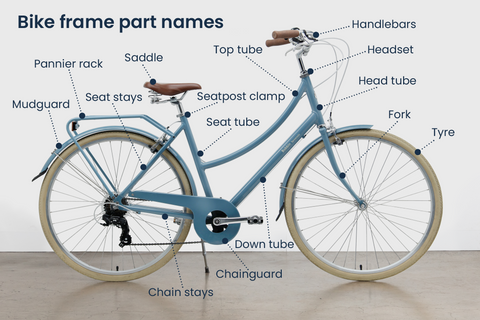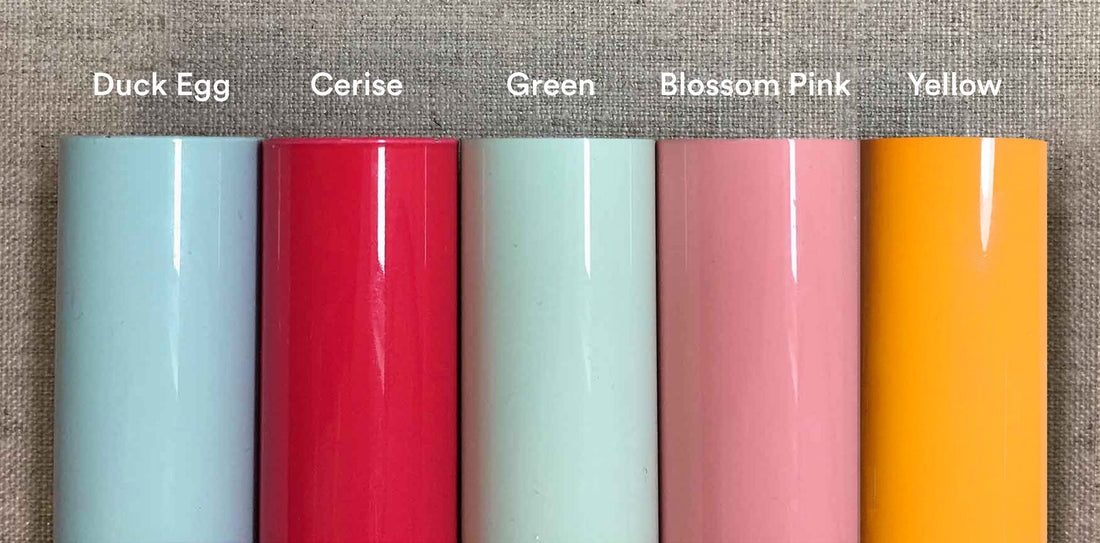Bike Part Names - Here is What All the Parts are Called
Whether you’re looking for replacement parts or wanting to customise your bicycle, you might have found yourself wondering: what’s that part of the bike called? Here is our complete guide to the names of bike parts.
Not all bikes will have all the same parts. Kids’ bikes, for instance, might come with stabilisers but won’t have gears until you get to the bigger models.
For the purposes of this guide, these parts are all present on adult bikes. (Note: this does not cover electric bikes.)
Alternatively, here’s a complete list of parts, which we’ve broken into sections.
Bicycle wheel parts
Some of these parts appear on both the front and rear wheels of your bike, while others are only on the rear wheel as they pertain to the pedal driving.

Tyre - The rubber around your wheel. This should be covered in grip and filled with air (not easy to squeeze) in order to be safe to ride.
Rim - The main metal ring of the wheel, which you can see inside the tyre.
Inner tube - You can’t see this, but this is a tube which sits in between the tyre and the wheel rim. This is the part that fills with air. In the event of a puncture, you can buy a replacement inner tube for a bike.
Valve - The little cylinder with a screw-on cap on the end, where you fill the tyre up with air. This is attached to the inner tube and fits through a hole in the wheel rim.
Spokes - The thin metal bars that go from the rim to the middle of the wheel. These hold the wheel together and attach it to its axle. Where they meet the rim, you may find that the spokes go into little holding cylinders called spoke nipples.
Cassette - Part of the gear system, the cassette looks like a group of cogs or sprockets and can be found next to the centre of the rear wheel. This is the part that the bike chain is attached to, which turns your wheel when you pedal. The chain will shift between different levels of the cassette when you change gears. Bobbin bikes use Shimano cassettes for smooth shifting.
Brake - The brake isn’t the little handle that you pull to slow down - that’s just how you activate it. The brake itself is the little pair of pads that squeeze the rim of your wheel when you pull the handle.
Mudguard - If your bike has a solid cover over part of the top of the wheel, this is a mudguard. It stops the wheel from splashing you with mud or water when riding, which also helps keep the rest of the bike clean.
Reflector - A shiny plastic part, usually silver or red, to help make you noticeable in reduced visibility conditions. Sometimes these are attached to the spokes, but sometimes they are affixed to the mudguard or the bike frame to be forward or rear facing.
Derailleur - On a bike with gears, this is the part that hangs beneath the cassette, containing a small cog and with the chain running through it. Basically, the derailleur is the mechanism that moves the chain from one gear sprocket to another when you change gears. Some bikes have multiple derailleurs, particularly if there are multiple gear shifters. The derailleur on your rear wheel is itself made of multiple parts such as a hanger, cable, tension screws, and other small parts that we won’t get into here.
Bike frame part names
Your bike frame mostly consists of metal tubes. Here is what they are all called, as well as the other parts attached to the frame.

Top tube - The uppermost tube of the bike, which goes from the back to the front. On some vintage style bikes, this is curved to allow riders to easily step over.
Seat tube - The upward-pointing tube that holds up the saddle.
Seatpost clamp - The clamp at the top of the seat tube, which you can open and close to adjust the saddle height.
Seat stays - The two thin tubes which go from the top section of the bike down to the axle of the rear wheel.
Chain stays - Directly under the seat stays, another two thin tubes go from the rear wheel axle to the middle of the bike where the pedals are.
Down tube - The diagonal tube that goes from the pedals at the bottom up to the front of the bike near the top. Combined with the top tube and the seat tube, this completes a triangle to hold the frame together.
Head tube - The shortest tube, this one is at the front of the bike, with the top tube and down tube attached to it.
Fork - From the bottom of the head tube, the fork divides into two sturdy tubes that attach to the front wheel. Some bikes, especially mountain bikes, have suspension built into the forks to reduce impact over bumps.
Handlebars - The bar across the front of the bike, which you lean on and turn to steer. Sometimes these are straight, while some styles of bike have the bars in curved shapes.
Headset - The part that turns, where the head tube connects to the handlebar section.
Chainguard - Some kids’ bikes have a cover over most of the chain, to stop little fingers getting hurt in the mechanism and to prevent damage to the chain.
Names of bike handlebar parts
Here are the names of all the parts you can find on the handlebar section of your bicycle:

Grips - The parts that your hands hold onto when riding. Usually these are made of plastic, silicone, rubber or leather. But some of our bikes use vintage-style cork handlebar grips.
Shifters - The controls that you press with your thumb to change gears.
Brake levers - The parts that you squeeze with your fingers to apply the brakes.
Brake hoods - Parts that cover the hinged section of the braking mechanism, next to the brake levers.
Brake cables - Those wires that go from your brake levers, all around the frame of the bike and down to the brakes themselves. Inside the cable housing, a subtle tug of the cable from your lever is enough to clamp the brakes closed on the wheel.
Stem - The neck that holds the handlebars. Sometimes this is forward-pointing, holding the handlebars slightly further forward, so that they aren’t directly above the head tube.
Names of bike pedal parts
The pedals themselves are the pads that you put your feet on, but what about all the other parts of that mechanism? Find out what they are called here.

Crank arms - Otherwise known as cranks, these are the two bars that move when you are pedalling, set 180 degrees apart, turning the chain mechanism.
Chainring - The large pointed wheel that drives the chain when you pedal. This is usually found on the right-hand side of the bike.
Crankset - The collective name for the component of the chainring and attached crank arms, which sometimes come as a single part.
Bottom bracket - Acting as the axle for your pedals, the bottom bracket fits into a hole at the bottom of the bike frame and enables you to cycle smoothly.
Chain - The length of lubricated metal links that join your pedals to the back wheel. Your bike wouldn’t go very fast without it!
And there you have it. You now know the names of all the parts commonly found on most bicycles.
There are, of course, some bikes that have parts not mentioned here. Folding bikes, for instance, have parts connected to their folding mechanism which aren’t present on traditional bikes. Additionally, a toddler’s balance bike will be entirely missing everything connected to pedals, and usually brakes as well.
So whether you’re looking for replacement parts, undertaking bike maintenance, or just want to look smart to your cycling friends, you now know everything you need!








